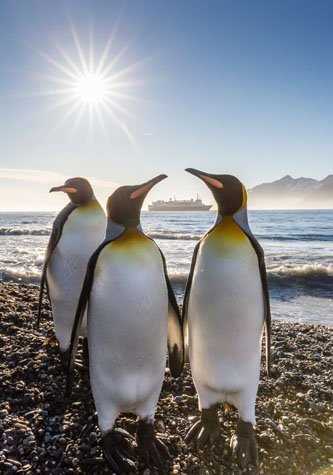Long before the sun rose, the one and only early morning wake-up call for those willing to brave a first light landing came from our expedition leader, Lisa Kelley. We landed on the beach just before the break of dawn and watched and photographed in amazement as the sun painted the 6,000 plus foot summits of Mount Roots, Mount Kling, Mount Brooker, and Nordenskjold Peak with soft pastel pinks and yellows. Combined these snow-covered mountains make for an incredible backdrop for the largest king penguin and elephant seal colonies in all of South Georgia.
Dear reader, there is no way we can possibly convey to you in any words, in any language, or in any photograph or video the absolute spectacle that nature has on display here at St. Andrews Bay. The sights, the sounds, and indeed even the smells are so overwhelming that it is seemingly impossible to make sense of the chaos. Surrounded by literally hundreds of thousands of animals, each with its own motivations, trying to glean the multitude of stories that are unfolding right before our very eyes, ears, and nose is quite the challenge. The morning passed much too quickly as we endeavored to commit to memory (and memory cards) as much as we possibly could.
Our afternoon, a place less grandiose but more intimate than the morning, was the snug little bay known as Ocean Harbour. The National Geographic Explorer anchored in the small bay of what once was a shore based whaling station. All that remains to remind us of the New Fortune Bay whaling station are scattered remnants of the whale processing machinery and a handful of gravesites. The wreck of the Bayard, a magnificent iron-hulled three-masted barque, which was blown from her moorings and ran aground in 1911 lies where she has sat ever since. Ironically, one of the largest colonies of blue-eyed shags in South Georgia build their nests in the tussac grass that has over-grown her wooden decks. While some chose to explore the small harbor via Zodiac, others ventured the gentle slopes around the station by boot. All encountered sparring elephant and Antarctic fur seals that have reclaimed the station grounds.
From sunrise to sunset, perhaps the most intense expedition day so far, stay turned for more adventure.









